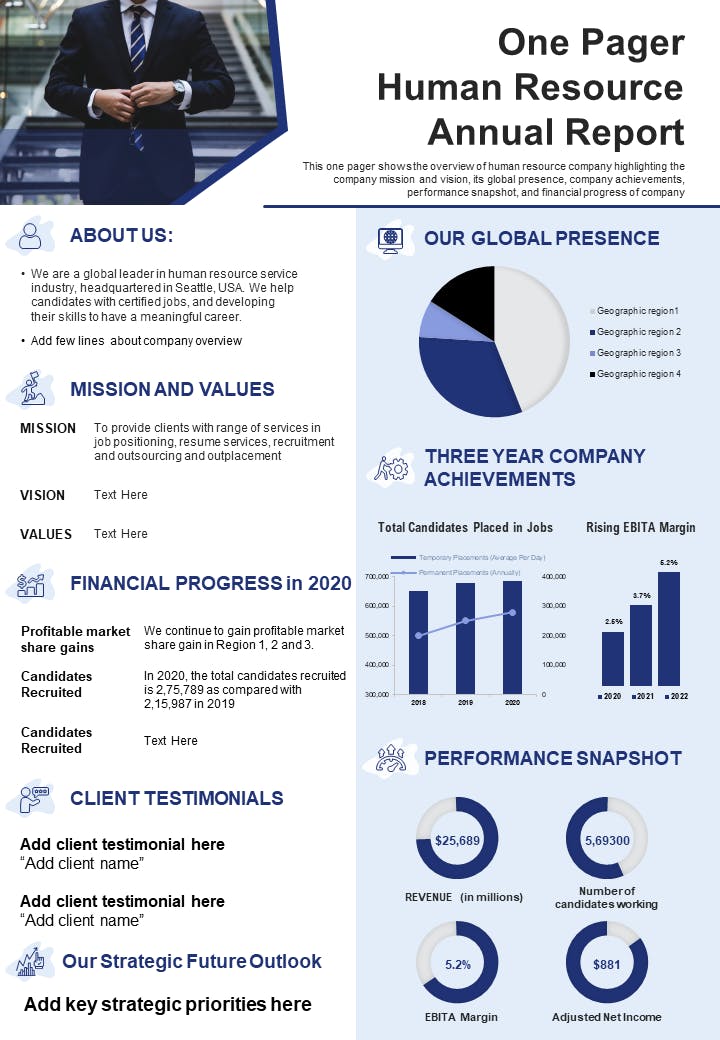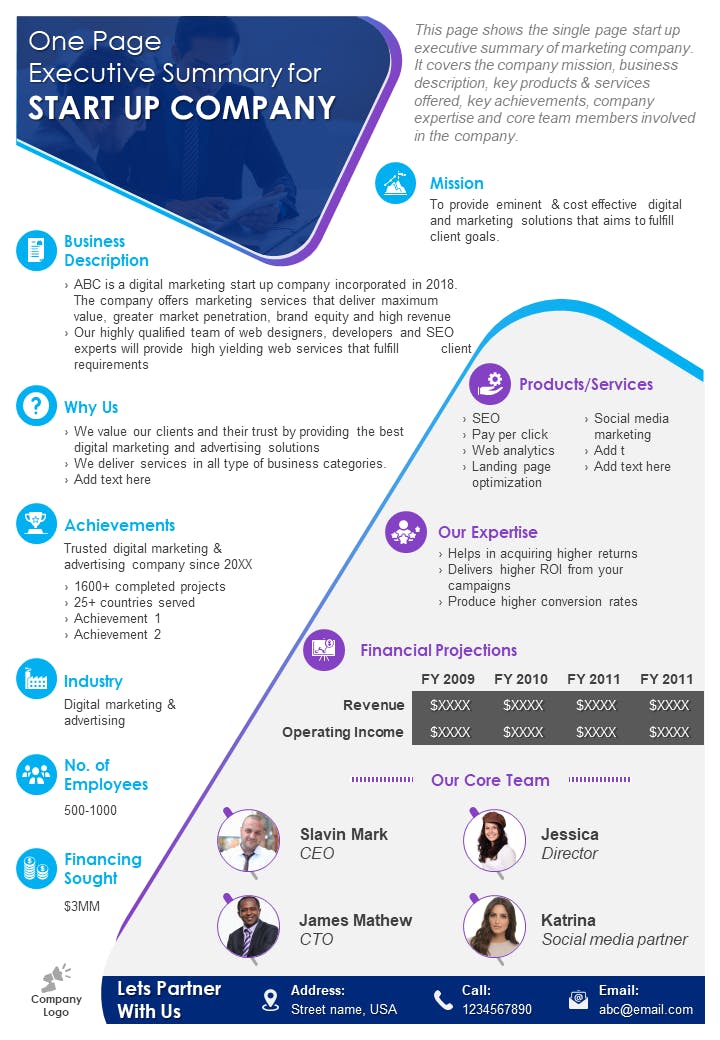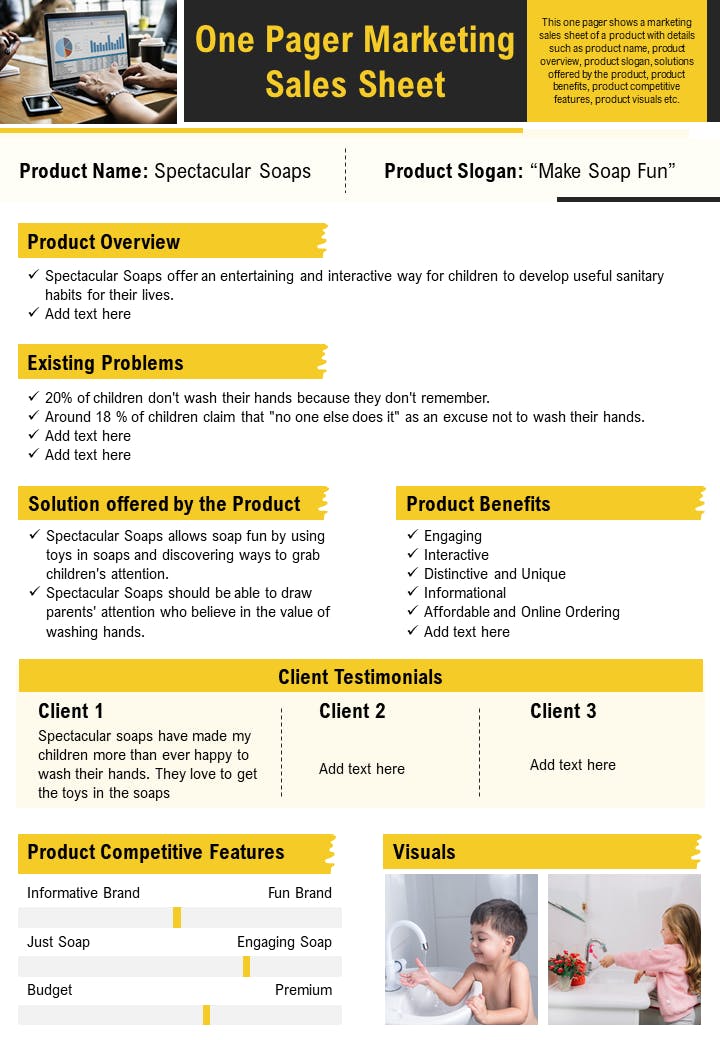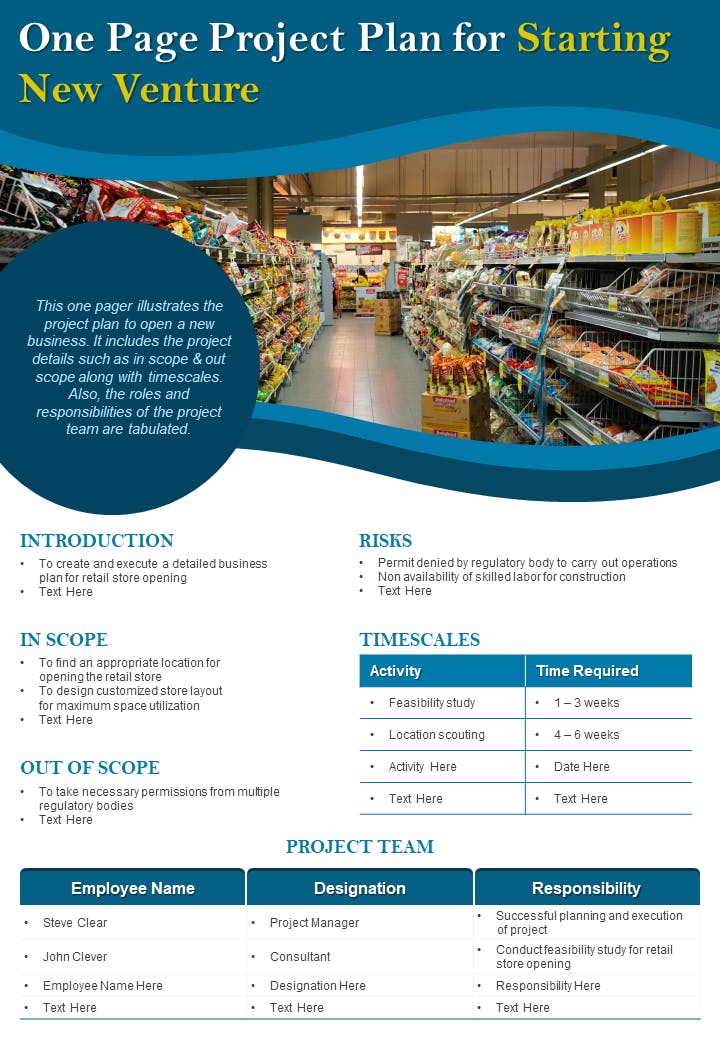One-pager: how-to, types and examples
Sep 10th, 2021

One-pager is a powerful marketing asset and a brilliant way to describe the benefits of your business in a clear and concise form. It is an excellent opportunity to deliver an outstanding first impression, educate your customers, and increase brand recognition. Moreover, creating one-pager challenges you to analyze your company and estimate the overall business concept, the current state of affairs, goals, and financial requirements.
With an impressive one-pager, you will arouse interest and get people to notice your business and understand the key ideas. It will provide a simple way to communicate your concept to potential investors, convince them your venture is worthwhile and encourage them to ask for more information.
What is a one-pager?
One-pager is a document that presents an in-depth description of the product, service, or company within a single page. The overview summarizes the principal points about your business — brief description, offering, mission, vision, value proposition, strategic goals, and key initiatives. One-pager has several purposes, including promoting a business to other companies, investors, or potential customers, providing information about your company to the media, or obtaining support for a specific cause.
The main objective of a one-pager is to advertise your business or pitch your product to the reader. The document intends to draw the customers’ or investors’ attention to your brand and convey value. Some of the advantages of writing the one-pager are as follows:
Cohesive messaging. One-pager allows for ensuring that the company’s message is consistent both internally and externally. The outline helps you focus on the most crucial points by presenting the comprehensive business proposal on a single page. Thus, it increases your understanding of the business and enables you to identify what is missing from the strategy and needs improvement.
Conciseness and clarity. You can use a one-pager to communicate your offering in correspondence due to its small format. The outline saves time and describes the core of your business.
Convenience. It is easier to edit one-pager than to update the overall business plan. You can publish the one-pager on your company’s website and keep the information up to date with minimal effort.
One-pager format
The fundamental elements of every compelling one-pager are content and design. It is essential to find the balance between text and images. Besides the main components, such as brand, logo, and positioning statement, you can include pictures, short customer testimonials, relevant metrics, and a call-to-action. Let us review the most critical elements of the one-pager in detail.
Brand identity
Company name, logo, and tagline are the crucial components. They are usually located at the top of the page. These elements should be listed first to make a reader remember the basic information about your brand. You can also add the social media account name to provide the opportunity for investors and clients to connect with your company.
Positioning statement
The next section of the one-pager is often dedicated to the positioning statement. This is a sentence that describes your brand’s unique value in comparison to the primary competitors in the market. The positioning statement should focus on your core customers, express your realistic brand promise and help you make more effective advertising and marketing decisions.
Suppose you are writing an investor one-pager or product one-pager. In that case, you can replace this section with a goal, the primary value your product delivers, or the potential the investment can achieve in the future.
Product overview
Make a short description of your product or service. Highlight the core features and the advantages of each characteristic. In this subsection of the one-pager, you need to explain why your product is worth investing in and how it would improve the customers’ lives. Present the benefits in a convenient form, such as illustrations, diagrams, and bulleted lists to keep the audience engaged. Provide a call-to-action to encourage the readers to move to the following stage of the buyer’s journey.
Executive summary
The executive summary includes a comprehensive overview of your company and its main activities, goals, differentiation strategy, and what you are offering to the investors. You can also provide information about the solutions you have developed, your major accomplishments, and list the main points of your business timeline. In addition, the section with the executive summary may contain the market research and metrics that demonstrate the product’s effectiveness in the future.
Funding goals
If you are creating an investor one-pager, Indicate the approximate amount of money you intend to raise and how you are going to use the funding. You need to put forward the arguments why you need a particular amount of resources. Pay attention to the objectives you want to achieve, such as sales growth, product development, or product/market fit. Include in your budget the additional costs for unexpected situations.
Problems and solutions
Prepare a list of the challenges and issues that your service will address and describe the consumers’ concerns. Consider how your product can make the customers’ lives easier. Discuss how your product or service would solve the problems and why your business will be the best choice for this purpose. Your problems and solutions should be specific, clear, and relevant to the customers’ needs. Illustrate the primary advantages of your product or service and focus on the most crucial aspects instead of using long descriptions.
Team and contact information
Add the contact details with a physical address, email, phone number, and social media channels. Provide information about your team members and their role in your business. If you are creating a one-pager for a startup, pay special attention to this part. Investment decisions are frequently made taking into account the team rather than value proposition, offering, or brand. A strong team can address any issue, while a poor team can ruin even a successful company.
One-pager examples
Let us consider the specific examples of one-pagers for different purposes. There is no standard layout or template. You can vary the content and sections according to your requirements.
Company/business one-pager
Company one-pager is a document that allows for communicating the core ideas about the product or service on a single page. When a business grows and expands the target audience, a one-pager is the necessary tool in helping explain your offering in a short time. The primary objective of a business one-pager is to capture the attention of potential customers and encourage them to learn more about your company.
A business one-pager is also a powerful way to present your company if you seek to attract investment. Instead of preparing a large presentation, you can provide a one-pager with a brief overview of your business. This would be enough for investors to understand whether they are interested in your services or products.
The main elements of the company or business one-pager include name and logo, pain points, solutions, product characteristics, call-to-action, contact information, and customer reviews or testimonials. You can add the blocks with an analysis of the company’s financial progress, achievements, strategic priorities for the future, and performance review. The one-pager should reflect your business personality, so the design and color scheme should match the visual part of your brand.

This example illustrates a template of a human resource company’s one-pager. The main goal of creating the document is to generate leads and to achieve brand recognition. The target audience of this one-pager is investors, employees, and other interested parties. The document includes information about the company, mission and values, global presence, financial progress, performance, achievements, client testimonials, and plans for the future. Clear and simple design does not distract attention from the content. Small illustrations and diagrams help emphasize the main points of the presentation.
Marketing one-pager
Marketing one-pager is a powerful tool to sell the product or service to the reader and increase sales. The main difference of the marketing one-pager is the focus on the value for potential buyers and clients. You can share the marketing one-pager via different channels, including email and social media, print it out and distribute it at trade shows or sales meetings or publish the document on your website.
The target audience of the marketing one-pager might include customers, investors, and potential business partners. The document usually contains the following elements: company name and logo, product description, pain points, solutions, features and benefits, call-to-action, customer reviews, and contact information.

This layout by Mercedes-Benz is a perfect example of a marketing one-pager. It does not provide much detail, but it illustrates only the benefits of the product without the pain points and features. The primary advantage of the design is minimalism, visualization and the emphasis on the emotions evoked by the solution. The Mercedes-Benz team has developed this one-pager specifically for the company’s website. The text occupies only one page, so it takes a little time to read it, but the interested person can always follow the link and get more information.
Startup one-pager
The main goal of preparing this type of one-pager is to convince the potential investors of the startup viability and the product’s usefulness during the fundraising stage. The startup one-pager allows for clarifying the unique value proposition and the product’s position in the market. The central requirement of the startup one-pager is concise, reasonable, and persuasive writing.
Before creating the startup one-pager, it is important to determine the purpose. The startup one-pagers have different target audiences and objectives. The target audience of the startup one-pagers usually includes angel investors and venture capitalists. The startup one-pager often contains various sections, such as company name and logo, team, single-line pitch, problems and solutions, target market, financial details, sales strategy, major competitors, milestones, and customer reviews.

This example of the startup one-pager includes a detailed analysis of the company — description, industry, number of employees, financing, mission, products and services, team, future projections, and contacts. The primary advantage of the template is the design that divides the page into two parts and bulleted lists, which makes it easy for perception. Despite a massive amount of information for one-pager, it is presented in a clear and understandable way and divided into logical content blocks.
Product one-pager
Product one-pager is a marketing document used as sales enablement content in the customer’s journey. The main aim of the product one-pager is to provide a brief description of your product or service to inform your customers, build brand awareness and nurture leads. This document can serve as a sales pitch for potential investors or the marketing asset for your sales team that can be distributed to partners, clients or prospects.
The product one-pager typically contains the target audience, product positioning, pain points your product addresses, solutions and gains, core features of the product or service, customer testimonials, and a company overview. Being one of the product marketing assets, the main difference between the product one-pager is the focus on one solution, while the company one-pager usually describes a range of products.

This product one-pager presents the sales sheet of ‘Spectacular Soaps’. It includes name and slogan, product overview, problems, solutions, benefits, client testimonials, product competitive features, and images. The advantages of this example are bulleted lists, product visuals, and minimalistic design. The competitive features of the product are presented in a simple scheme that provides visibility.
Investor one-pager
The intrinsic purpose of the investor one-pager is to persuade investors to inquire more information about your product or service and to believe it is worth implementing. Investors often receive a lot of information about the new opportunities, so you need to present your offer in a straightforward and appealing way to save time and demonstrate the core value of the product.
The investor one-pager should provide the data about the product’s value, competitive advantage, one-line description, market and competitors overview, and your business model. The other possible elements might include the information about the marketing strategy, founder team and advisors, funding and use of money, past and future milestones.

This investor one-pager template provides the essential details, such as timescales, risks, and project team. It can serve as a convincing pitch for the investors as it allows them to see the general picture at once, evaluate the risks and the required amount of time, and get acquainted with the team. In addition, the template contains a photo that helps to visualize the final stage of the project.
How to write a one-pager
The perfect one-pager should describe your company, product, or service in a concise and compelling way. It outlines the core of your business — your offering, competitive advantage, and the benefits that allow you to stand out from the competition. The excellent summary evokes interest, saves time, helps identify pitfalls and make well-informed choices.
The structure of the one-pager depends on several factors, including the purpose and target audience. You can adapt the design to your needs and requirements. You can prepare the one-pager with the maximum amount of information segmented into the blocks. In other cases, as in the example with Mercedes-Benz, it is better to create a minimalistic document to encourage the reader to learn more. The design and content of the one-pager may also vary depending on the format you’ll need — printable version or the version for the website.
As the main objective is to capture attention from the first sight, it is vital to consider the design, pictures, and diagrams. The visuals should not distract the reader from the content, and at the same time, they should illustrate the core ideas.
Here are the basic steps to create a compelling one-pager:
Make it easy to read, understand and remember. Avoid redundancy and unnecessary details. Structure the content into sections and blocks. Use the lists and short sentences. Add the most important details at the top of the document. Consult with your team to ensure that you have not missed some essential information before finalizing the document.
Create an eye-catching design. The visually appealing layout is the key to success. Use the colors that reflect your brand personality. Include images, logos, tables, and illustrations. Make the responsive design if you are going to share the one-pager across different platforms.
Include a call-to-action in the final section. Add the contact details, such as email, phone number, address, and links to social media. If you want to publish the one-pager on your website, you can add CTA buttons, such as “Continue”, “Learn more” and others.
